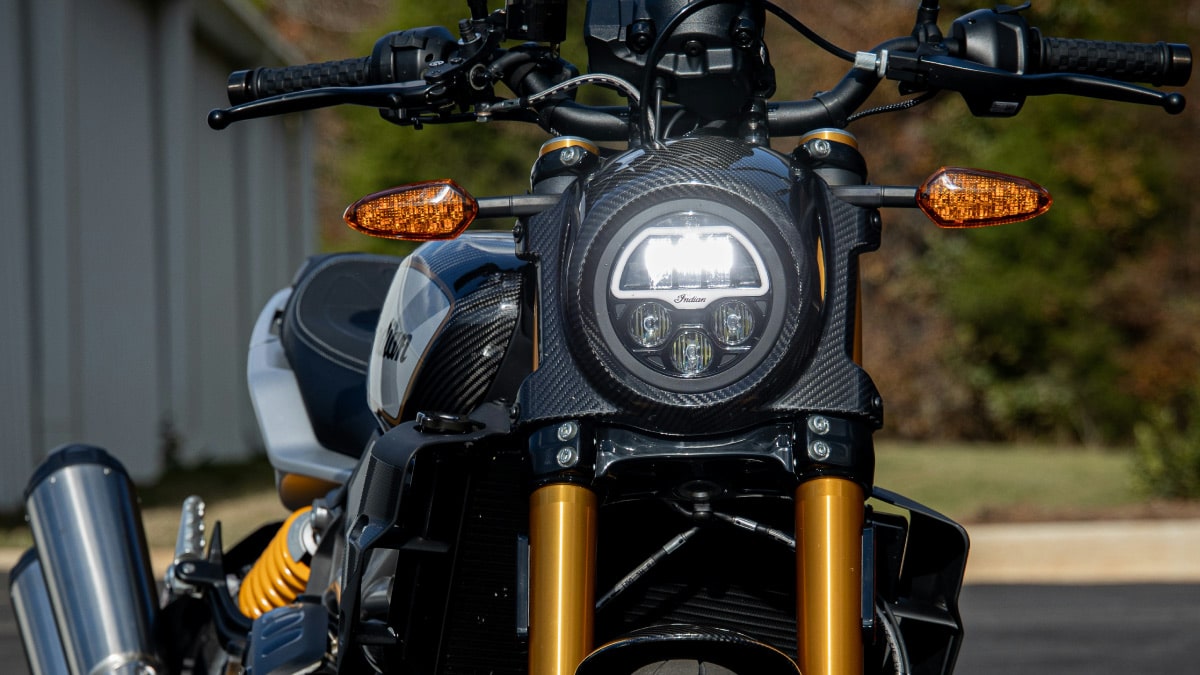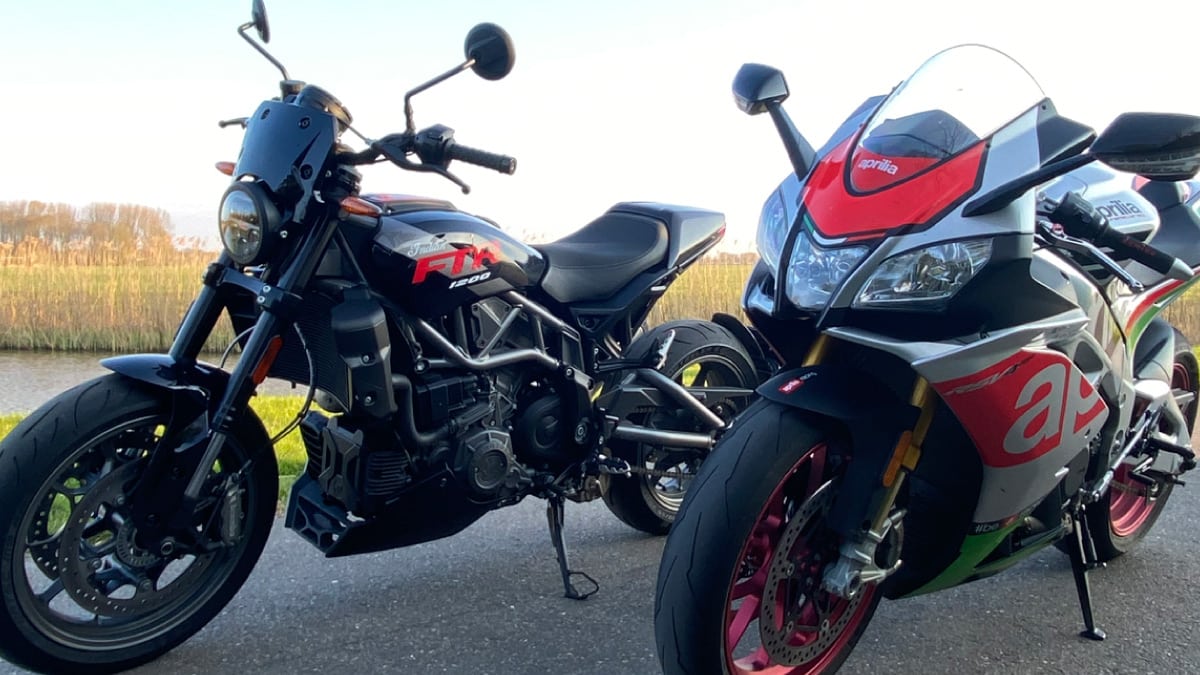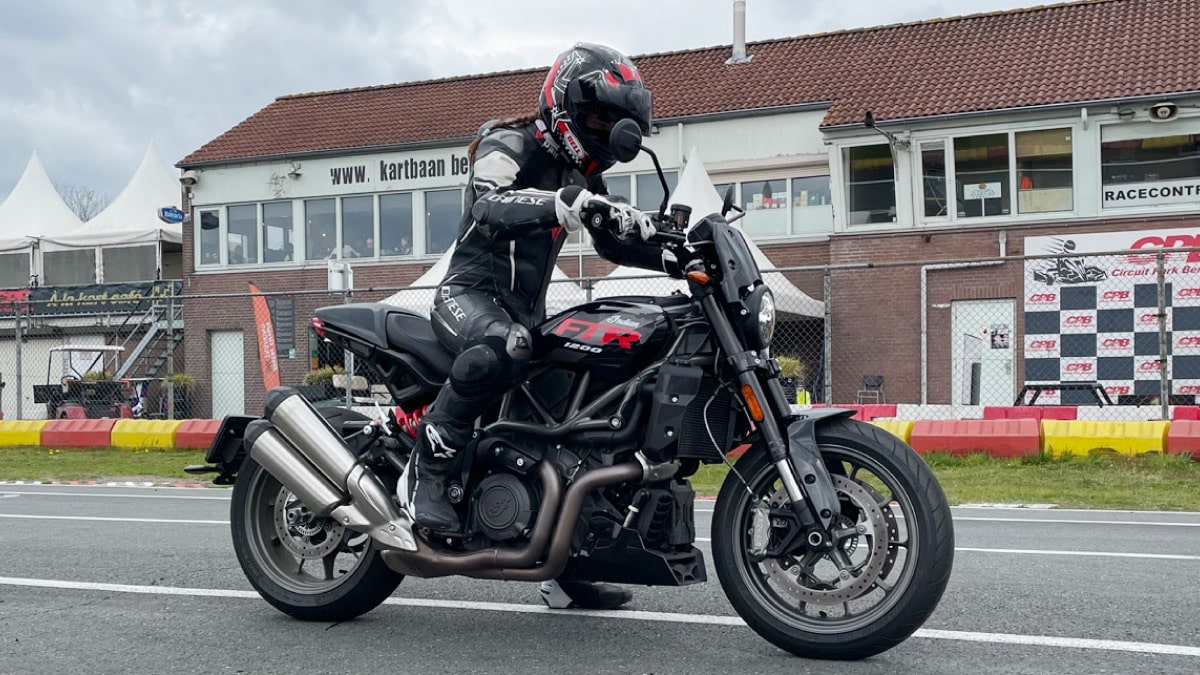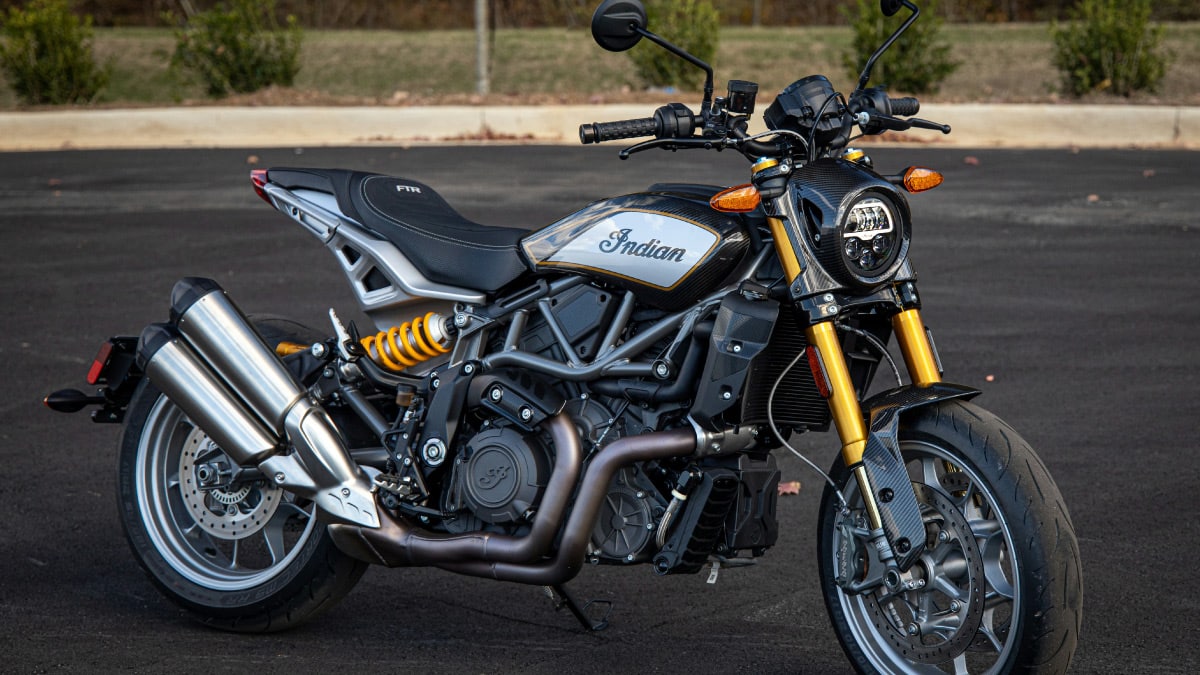THRYLLZ
Thrills we thrive on
Thrills we thrive on
When you think of Indian Motorcycle, large cruisers immediately spring to mind. But did you know that this brand also has a sporty side? Or rather, had. More on that later. Meet the Indian FTR. How sporty is this bike really?! Find out in this Indian FTR review.
I’ll be honest. I didn’t know what to expect from the FTR. It actually sounded like some kind of bad joke. ‘Normally we make huge motorbikes, especially big cruisers. But this time we’ve built a cool, small and sporty motorbike. We promise you, it’s good.’
But while we’re confessing… I also didn’t know that Indian Motorcycle had a history in Flat Track racing. And that they were, and still are, so successful at it! At that point, I also didn’t know that the FTR is also raced on normal circuits. And that bagger racing is a thing.
I was asked to be the presenter and rider for a promotional video for the FTR. We were going to shoot video footage both on the road and on a smaller circuit in Berghem, next to the famous motocross track. A few days beforehand, I was allowed to take the Indian FTR home with me. To get acquainted with it, you might say.
So I tested it extensively on the roads near my home. Roads that I know well and have already ridden with many different motorcycles. So comparing one motorcycle to another is becoming more and more fun.
Because this is not a sponsored article, or an article written after an invitation to a demo ride or something similar, I can tell you all the good and bad things about the Indian FTR. No censorship, just my honest opinion and experience.
So here we go. Our review of the Indian FTR 1200, the Sport version.
I make no secret of my preference for good looks. I know that many people prioritise functionality over appearance, or seek a certain balance. But I don’t mind sacrificing some – or a lot – of comfort for a sleek appearance.
And man, oh man, I love the looks of the FTR. I think it’s really cool to look at. The sporty rear, the narrow profile… The subtle hints to the FTR’s flat track history. It’s a beautiful balance and, above all, gives it a cool, sporty look. I know it’s subjective. But hey, I’m just saying what I think. I’m not a motorbike journalist. I’m just a passionate motorcyclist.
In my opinion, Indian Motorcycle has done a good job in terms of design. The FTR is different. It has a long wheelbase. Perhaps a little too long, especially compared to what we are used to from short Italian and Japanese bikes. But it’s cool. And when I look at it, I get a lot of inspiration to customise it.
Engine: 1,203 cc 60-degree V-twin
Power: 120 hp @ 6,000 rpm, 117.9 Nm @ 6,000 rpm
Seat height: 780 mm / 30.7 inches
Fuel tank capacity: 12.9 litres
Dry weight: 223 kg / 490 lbs
Top speed: approx. 220 to 230 km/h / 147 mph

After taking a good look at the FTR, I jump on that bike. The FTR Sport, to be precise. And you’ll never guess… I could actually reach the ground with my feet. No flat feet, but definitely no tip-toe work either. I’m 1.68 m tall, in case you’re wondering.
The handlebar feel wide when you grab the grips. Almost motocross style. Probably no wider than those of a regular naked bike or streetfighter. I normally ride supersport bikes on the street. So the handlebars immediately remind me of my motocross bike rather than a street bike.
It gives you a nice “elbows out” vibe. Without giving too much away, it turns out that’s how you’re supposed to ride it. But more on that later on.
Put your feet on the footrests and you’ll immediately notice that they’re quite low to the ground. This gives taller riders more space. I spoke to a young man who owns an FTR and is quite tall (2 metres). He found the FTR to be the most comfortable naked bike he had ever ridden. And he had tried quite a few different naked bikes, as he was busy looking for one that suited his height.
When you put the motorbike in first gear and ride off, you immediately notice that the FTR is sporty on the throttle. The Indian FTR 1200 has a V-twin engine that feels very smooth. It growls, and feels solid.
It was a hot day when I took the FTR home. And at the first traffic lights I came to, I noticed that the engine was idling at a higher revs than I had expected when I closed the throttle. I wasn’t sure what to make of it, so I left it at that. At the second traffic light, it happened again, and I started to get a little nervous. I saw an icon light up on the dashboard. A V-twin engine with a red cross through one of the cylinders. ‘Have I already wrecked it?!’ I thought.
After a quick check, it turned out that this is standard procedure. The rear cylinder “shuts itself off” to prevent the engine from overheating. And to prevent you, the motorcyclist, from getting fried. It’s an issue with many V-engines. It’s difficult to cool the rear cylinder. Indian Motorcycle developed a system where the rear cylinder shuts itself off when you are stationary. Pretty smart, if you ask me. But something you have to get used to.
Does your right hand also tend to feel heavier and faster than your left? Welcome to the club. In that case, one thing will immediately strike you about the Indian FTR. It’s a real torque party. The 1,200 cc V-twin engine works hard for you. Not only does it give you 120 horsepower to play with, but also 117.9 Nb of torque at 6,000 rpm.
Let’s put that into perspective. That’s just a little more than my own Aprilia RSV4 (which delivers 117 Nm at 10,500 rpm). And certainly more at 6,000 rpm. It also outpaces the BMW S1000RR in the first few metres at the traffic lights. Yes, I know, these are sport bikes and therefore not designed for high torque at low revs. But these are the machines I often ride. If we compare it to a big naked bike, it comes very close to the Ducati Streetfighter V4S. And that with a considerable amount less power. Not bad for an American V-twin.

Although the Indian FTR offers plenty of space for taller riders, it is also a great bike for shorter riders. The seat height is only 780 mm, or 78 cm, which is not high. It is a slightly wider bike, so I can’t put my feet flat on the ground. But I can still comfortably rest most of my feet on the ground. Are you around 1.68 m tall? Or slightly shorter? Then you will definitely be able to reach the ground.
Are you much shorter? Then there are still options to lower the FTR.
I have a second confession to make… I’m not a fan of naked bikes. At least when it comes to riding. And yes, I know. I’m a bit of an oddball in this regard.
But if I want to ride something sporty, I choose a sports bike. I don’t see the point or the fun in combining sporty riding with comfort. I see the advantages of sitting a little more upright. But I don’t (yet) feel the need for this. So I prefer to ride a sports bike.
And I certainly don’t see the point of a 200 hp naked bike. That mainly means that the bike becomes heavy and doesn’t have the ground clearance you would want it to have in order to actually use that 200 hp. I know it’s an unpopular opinion, but I prefer sports bikes to naked bikes.
That said, I did really enjoy riding the Indian FTR. And I think that’s because you have to wrestle with this bike a bit. Don’t get me wrong, it’s very ridable. But if you really want to go fast, it becomes a struggle.
Not because it’s heavy, but because this motorbike has a slightly longer wheelbase. And I like that. It feels different. It’s “riding with your elbows out”.
It’s just different. This motorbike looks different and rides differently. And I find that intriguing.

Is the FTR perfect? No. No motorbike is perfect. There’s always something to complain about. And since I’m a typical Dutchie, that’s exactly what I’m going to do.
1. The FTR has a small fuel tank. If you plan to ride 500+ kilometres with a group of motorcyclists, keep in mind that you will have to stop a little more often than they do. But that’s a good excuse for an extra cup of coffee.
2. It doesn’t have a quickshifter. I mention this because many would point to this as a definite disadvantage of the Indian FTR. So I’m mentioning it too. But I also have another message for you…
‘Grow up. Don’t be such a lazy pig. Shift gears yourself. Use the clutch. If you don’t know how to use a clutch (anymore), get off the bike and drive a car.’
In my – probably equally unpopular – opinion, quickshifters are hugely overrated on the road. Unless you’re a true street hooligan who makes the roads unsafe early in the morning. In that case, I get it. You want a quickshifter. But given that 9 out of 10 motorcyclists are not, and don’t have the skills to do so, I say, ‘Use that clutch and stop complaining.’
3. The low footrests cause a lot of scraping on the asphalt. That would be one of the things I would change if I bought an Indian FTR. Put a good aftermarket rear set on it, which allows you to adjust the height of the footrests.
You can also just use your body and keep the motorbike straighter in the corners. That works too, of course. So it’s not that the standard footrests get in the way on the road, as long as your body posture is correct.
But I often look at street bikes a little differently, especially when they’re sportier motorcycles. I see them as a possible replacement for my race bike, in case I crash it. And on your occasional track day, those low footrests do get in the way. Especially when you’re going faster around the track.
But that’s about it, really. I can’t think of many other disadvantages.

I know this question is very personal. But yes, I would buy the Indian FTR. And this is the first time I’ve ever said that about a naked bike, or semi-naked bike.
I’m a fan. I like it, and I think the design is fantastic. Take off the mirrors. Put mirrors on the handlebar ends, hanging below the handlebars. Fit an aftermarket brake and gear lever set, spray it in a bold colour that screams “street hooligan” and maybe, just maybe, fit Öhlins suspension. The latter isn’t strictly necessary, by the way, if you’re mainly riding this bike on the street.
And now for the bad news: Indian Motorcycle discontinued production of the FTR in early 2025. They did this quietly, without any major announcement. The American brand has been struggling for a long time, and sales figures for the Indian FTR were disappointing. A shame, if you ask me.
I can’t resist giving my opinion on this subject, not only as a fanatical motorcyclist but also as an experienced marketing manager.
In my opinion, it’s a mortal sin that Indian never put this bike head-to-head with other modern naked bikes. Let it compete with the Ducati Monster and the Kawasaki Z900SE, to name just a few models. Yes, then its shortcomings will also come to light. But you can also beautifully highlight why the FTR does have a right to exist.
The Indian FTR rides beautifully, has a smart and funky design, lends itself wonderfully to customisation and also holds its own on the track. It is sporty bike with an attitude. And it’s a V-twin. That alone makes it a cracking machine in my eyes, and unique enough to build a good story around it.
The Indian FTR. Whether you go for the basic FTR 1200 model, the FTR Sport, or the Carbon version… they all look damn good. I know it’s a matter of taste, but I love the bold looks.
I think that’s what defines the FTR. It’s different. It’s fresh. It’s a bold take on the modern naked bike. It has everything you need. It’s missing a few things you might want, like a quickshifter. But let’s be honest, most of us don’t need that. Or, in all fairness, shouldn’t be using it.
The FTR asks you to wrestle with it. Especially when you’re flying down winding roads at high speed. But it asks in a very charming way. I know that many people wouldn’t think of Indian Motorcycle in their search for a naked bike. But give the Indian FTR a chance. I promise you won’t regret it. You might even take it home with you. One thing is certain: the FTR is addictive.
We use cookies to improve your experience on our site. By using our site, you consent to cookies.
Websites store cookies to enhance functionality and personalise your experience. You can manage your preferences, but blocking some cookies may impact site performance and services.
Essential cookies enable basic functions and are necessary for the proper function of the website.